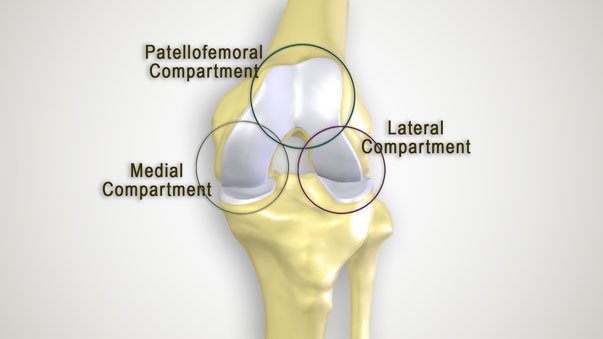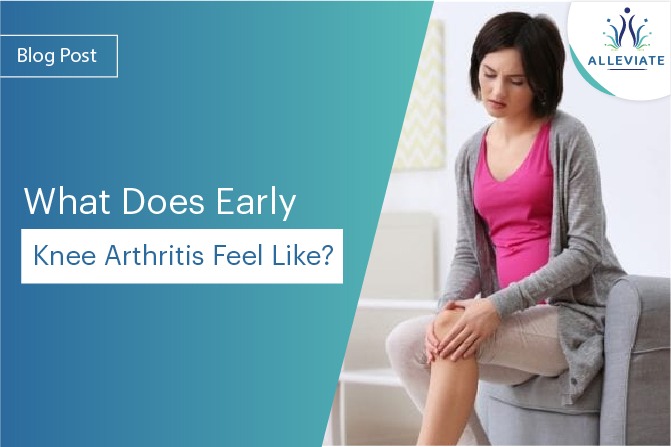Introduction
Knee arthritis, a condition characterized by the degeneration of the knee joint’s cartilage, affects millions of people worldwide. In its early stages, knee arthritis can be subtle and may go unnoticed. However, understanding the signs and symptoms is crucial for early intervention and effective management. In this blog, we will explore what early knee arthritis feels like, where the pain is located, when it typically occurs, which activities can aggravate the pain, the impact on daily routine activities, and the potential benefits of treatments like Platelet-Rich Plasma (PRP), Prolotherapy, and stem cells based on our experience at Alleviate Pain Clinic and references from published articles and medical journals.
What Does Early Knee Arthritis Feel Like?
Location of the Pain
Early knee arthritis typically presents with pain on the inside of the knee joint.(medial aspect) Patients also commonly report discomfort in the front (anterior), and behind(posteriorly)the knee and sometimes on the outer(lateral aspect). The pain can radiate down the shin or thigh, and it may also be felt in the surrounding soft tissues.

When Does Knee Pain Occur?
Knee pain in early arthritis often occurs during or after weight-bearing activities, such as walking, climbing stairs, or standing for extended periods. Initially, the pain may be intermittent, but as the condition progresses, it can become more constant.
Activities that Aggravate Knee Pain
Certain activities can exacerbate knee pain in early arthritis. These include:
- Strenuous Exercise : High-impact exercises or sports that involve running and jumping may worsen knee pain.
- Prolonged Standing : Activities that require extended periods of standing can lead to discomfort.
- Cold Weather : Some individuals with early knee arthritis report increased pain and stiffness during cold weather.
Stiffness After Sitting for Long
One hallmark of early knee arthritis is stiffness. Patients often experience significant stiffness in the knee joint after sitting or lying down for an extended time. This stiffness can make it challenging to stand up and move comfortably.One hallmark of early knee arthritis is stiffness. Patients often experience significant stiffness in the knee joint after sitting or lying down for an extended time. This stiffness can make it challenging to stand up and move comfortably.
Difficulty in Sitting Cross-Legged
Early knee arthritis can limit the ability to sit cross-legged or kneel. The pain and stiffness may prevent these positions, impacting one’s flexibility and range of motion.
Impact on Daily Routine Activities
Early knee arthritis can have a substantial impact on daily life. The pain, stiffness, and limited mobility may affect activities such as:
- Walking or climbing stairs
- Bending down to pick up objects
- Playing sports or engaging in physical activities
- Performing tasks that involve squatting or kneeling
Exploring PRP, Prolotherapy, and Stem Cells in Early Knee Arthritis Treatment
At Alleviate Pain Clinic, our experience has led us to recognize Platelet-Rich Plasma (PRP), Prolotherapy, and stem cell therapies as valuable options for treating early knee arthritis. These treatments are gaining recognition as first-line treatments for several reasons:
PRP (Platelet-Rich Plasma)
Dr Swagatesh with Platelet Rich Plasma preparation at Alleviate Pain ClinicPRP therapy involves using a patient’s blood, processed to concentrate platelets, growth factors, and other healing elements. Injecting PRP into the knee joint can promote tissue repair, reduce inflammation, and alleviate pain. Studies suggest that PRP can provide long-term relief and improve joint function.
Prolotherapy
Prolotherapy is a regenerative injection therapy that stimulates the body’s natural healing processes. It involves injecting a solution, often dextrose, into the affected area. Prolotherapy can strengthen weakened ligaments and tendons around the knee, leading to improved stability and reduced pain.
Stem Cell Therapy
Dr Swagatesh with Stem Cell preparation derived from abdominal fat at Alleviate Pain Clinic Stem cell therapy involves the injection of stem cells, often harvested from the patient’s own body, into the knee joint. These cells have the potential to regenerate damaged cartilage and promote tissue repair. Emerging research shows promise in the use of stem cells for knee arthritis treatment.
In conclusion, early knee arthritis is marked by pain, stiffness, and limited mobility that can affect daily activities. While the condition can be challenging, innovative treatments like PRP, Prolotherapy, and stem cell therapy have shown promise in alleviating pain and promoting joint health. Early intervention, coupled with these regenerative therapies, may help individuals regain their quality of life and avoid more invasive procedures in the future. Always consult with a healthcare professional for a proper diagnosis and personalized treatment plan.





